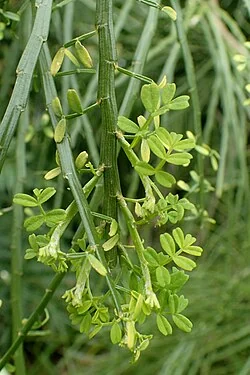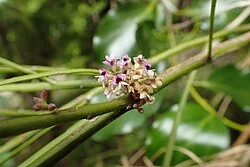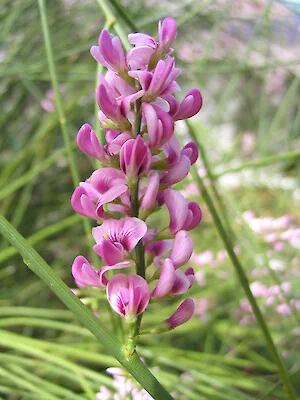
Scented Broom
Carmichaelia odorata
Explore more NZ native plant guides in our index .
Introduction
About Scented Broom
Carmichaelia odorata , commonly known as Scented Broom, is a slender, leafless shrub endemic to New Zealand's North Island (southern regions) and South Island (northern and western areas), distinguished as one of the most aromatic members of the native Carmichaelia genus with its distinctive fragrant white and purple flowers. This substantial shrub reaches 3-8 m tall with a 2-3 m spread, characterized by numerous flattened green twigs arranged in elegant fans, each twig measuring 1-2mm wide with distinctive wavy edges that create an attractive architectural form. Unlike many other Carmichaelia species, this "leafy broom" retains scattered leaves with 1-7 leaflets along its photosynthetic twigs, while producing clusters of small, intensely fragrant flowers in erect short spikes from September through February. Primarily associated with river terraces, flats, streams, and forest margins throughout its natural range, this robust nitrogen-fixing legume demonstrates exceptional horticultural value through its ease of propagation from both seed and hardwood cuttings, extended fruiting period from January to September, and remarkable adaptability to diverse garden conditions while maintaining its distinctive aromatic appeal.

Plant Description
Carmichaelia odorata , commonly known as Scented Broom, is a slender, leafless shrub endemic to New Zealand. It is characterized by its numerous flattened green twigs arranged in elegant fans, with each twig measuring 1-2mm wide and having distinctive wavy edges. Unlike many other Carmichaelia species, this "leafy broom" retains scattered leaves with 1-7 leaflets along its photosynthetic twigs. It produces clusters of small, intensely fragrant white and purple pea-like flowers from September through February, followed by linear, laterally compressed seed pods. This nitrogen-fixing legume can reach 3-8 m tall with a 2-3 m spread and is primarily associated with river terraces, flats, streams, and forest margins.
Quick Facts
Shrub Summary
| Scientific Name | Carmichaelia Odorata |
|---|---|
| Height | 1-2 m |
| Spread | 0.5-1 m |
| Water Needs | Low; very drought-tolerant |
| Light | Full sun to partial shade |
| Frost Tolerance | High |
| Salt Tolerance | Moderate |
| Growth Rate | Moderate |
| Lifespan | Perennial |
Climate Best Suited to
Carmichaelia odorata is found throughout New Zealand in a variety of habitats, including river terraces, flats, stream margins, and forest edges across its natural distribution from the southern North Island through northern and western South Island regions. This adaptable endemic species excels in New Zealand's temperate climate, demonstrating particular affinity for riparian environments while showing remarkable tolerance for varying moisture conditions from well-watered sites to periodically dry positions once established, making it invaluable for restoration projects in diverse topographical settings.
Regional Suitability
| Whangārei | Ideal |
| Auckland | Ideal |
| Hamilton | Suitable |
| Rotorua | Suitable |
| Tauranga | Ideal |
| Gisborne | Ideal |
| New Plymouth | Ideal |
| Whanganui | Ideal |
| Palmerston North | Suitable |
| Napier | Ideal |
| Wellington | Ideal |
| Nelson | Ideal |
| Christchurch | Suitable |
| Dunedin | Suitable |
| Invercargill | Suitable |
| City | Climate Suitability |
|---|
Habitat
Natural Distribution
Carmichaelia odorata , commonly known as Scented Broom, is an endemic shrub to New Zealand. It is primarily found in the southern part of the North Island and the northern and western parts of the South Island, demonstrating a preference for specific regional climates.
This plant typically inhabits river terraces, flats, streamsides, and forest margins. While it can tolerate relatively dry conditions, it thrives best with sufficient moisture, making riparian zones ideal. It is also notably tolerant of frost, sun, drought, wind, and free-draining soil, showcasing its hardiness and adaptability to diverse environmental conditions within its range.
Plant Conservation
Conservation Status
Carmichaelia odorata is classified as "Not Threatened" under the New Zealand Threat Classification System, maintaining this stable conservation status consistently since at least 2004 through the most recent 2023 assessment. This endemic New Zealand species demonstrates good conservation security across its natural distribution range.
The species is distributed across the southern part of the North Island and the northern and western parts of the South Island, with populations primarily associated with river terraces, flats, streams, and forest margins. This riparian habitat preference provides some natural protection from widespread habitat modification, while the species' robust nature and ecological adaptability contribute to its conservation stability.
Scented Broom benefits from its excellent propagation success, being easily grown from both seed and hardwood cuttings. This cultivation potential provides opportunities for conservation through habitat restoration projects and ex-situ preservation. The species' extended flowering period from September to February and fruiting period from January to September demonstrate reproductive success and resilience.
As a nitrogen-fixing legume with fragrant flowers that attract diverse pollinators, Scented Broom plays important ecological roles that extend beyond the species itself. Its conservation value includes contributions to soil fertility improvement and pollinator support within riparian ecosystems. Continued monitoring of populations and habitat protection ensures the long-term security of this distinctive endemic species and its specialized riparian habitats.
Growing Requirements
Soil Requirements
Prefers well-drained, fertile soil with good organic content. Tolerant of a wide range of soil types, including sandy and clay soils.
Light Requirements
Grows best in full sun to partial shade.
Water Requirements
Requires consistent moisture, especially during dry periods. Once established, it is drought-tolerant.
Planting Guide
-
When to Plant
Plant in autumn or spring.
-
Site Preparation
Choose a sunny or partially shaded site with well-drained soil.
-
Planting and Aftercare
Dig a hole twice the width of the pot. Place the plant in the hole and backfill with soil. Water well and apply a layer of mulch.
Ecological Significance
Carmichaelia odorata , commonly known as Scented Broom or Leafy Broom, holds several ecological significances, particularly within its native New Zealand environment. As an endemic vascular shrub, it plays crucial roles in its specific habitats.
- Nitrogen Fixation: Like other species in the Carmichaelia genus, C. odorata is capable of fixing atmospheric nitrogen through specialized root nodules. This ability allows it to thrive in nutrient-poor or poorly developed soils, contributing to soil fertility in its habitats, making it valuable for ecological restoration.
- Habitat and Distribution: This species is found in the southern part of the North Island and the northern and western South Island. It typically inhabits river terraces, flats, stream banks, and forest margins. It can tolerate relatively dry conditions but thrives with sufficient moisture, and is noted for its hardiness, tolerating frost, sun, drought, wind, and free-draining soils, making it suitable for coastal conditions and exposed sites.
- Pollinator Support: Its sweetly scented purple and white flowers are attractive to pollinators, thereby supporting local biodiversity and contributing to the reproductive success of other flora in its ecosystem.
- Erosion Control: Due to its hardiness and ability to grow in challenging conditions, C. odorata is valued for erosion control, particularly in coastal areas where resilient plants are needed to stabilize soil.
- Adaptive Radiation: The genus Carmichaelia , to which C. odorata belongs, exemplifies adaptive radiation within the New Zealand flora, demonstrating rapid diversification to fill various ecological niches.
- Seed Dispersal: Its seeds are thought to be dispersed by wind and granivory (seed consumption by animals), aiding in its natural spread.
- Conservation Status: As of 2023, Carmichaelia odorata is classified as "Not Threatened" under the New Zealand Threat Classification System, indicating a stable population within its native range.
Uses and Significance
Garden Uses
- An excellent plant for rock gardens, borders, and coastal areas.
- Its leafless stems and fragrant, pea-like flowers make it a charming addition to any landscape.
Cultural Significance
Traditional Uses and Values
Scented Broom ( Carmichaelia odorata ) was used by Māori for various purposes. The tough, flexible stems were used for weaving and construction, and the plant also had medicinal uses in rongoā (traditional Māori medicine).
Landscaping Uses
Garden Design Applications
Carmichaelia odorata , commonly known as Scented Broom, is a versatile New Zealand native shrub highly valued in landscaping for its aesthetic and ecological benefits. It is particularly suited for native gardens and restoration projects due to its origin and low maintenance requirements.
- Ornamental Value: The plant is admired for its fragrant purple, white, or pink-lilac flowers that bloom in summer, and its fine-textured foliage. It forms an upright, bushy shrub with slender, pendulous branches, contributing a graceful and architecturally distinctive appearance to gardens.
- Pollinator Attraction: Its intensely fragrant blooms are effective in attracting pollinators, thereby supporting local biodiversity and contributing to the health of the ecosystem.
- Erosion Control: Carmichaelia odorata can be utilized for erosion control, especially in challenging environments like river terraces and stream banks, where its root system helps stabilize soil.
- Coastal and Hardy Plantings: This species is naturally hardy and tolerant of dry, exposed, and coastal conditions, making it an excellent choice for coastal plantings and other harsh sites. It also thrives in poor soils and is drought-tolerant once established.
- Design Applications: It serves well in mixed borders, naturalistic designs, and can be used for screening or as an informal hedge. Its adaptability makes it suitable for various garden styles, including alpine, backyard, city and courtyard, coastal, frontyard, Mediterranean, modern, and native gardens. It can also be planted around ponds and pool areas.
- Low Maintenance: As a low-maintenance plant, it requires minimal care once established, making it a practical choice for many landscapes.
- Ecological Benefits: Beyond its beauty, Carmichaelia odorata can fix nitrogen in the soil, contributing to soil health and benefiting other plants in its vicinity.
Seasonal Care Calendar
Spring
- Apply a balanced fertilizer and a layer of mulch.
Summer
- Water regularly, especially during dry periods.
Autumn
- No special care required.
Winter
- Protect from heavy frosts in colder regions.
Pruning and Maintenance
Simple Care
Remove any old, damaged, or yellowing stems as needed to maintain the plant's appearance.
Prune Scented Broom lightly to maintain structure; remove damaged shoots and avoid hard cuts on older wood.
How to Grow Scented Broom
From Seed
Scented Broom ( Carmichaelia odorata ) raises well from seed and this is the most dependable method for numbers. Harvest mature pods in late summer to autumn and extract the hard, glossy seeds. Like many legumes, they benefit from scarification to speed and even out germination: either nick the seed coat gently with a file, or pour hot (not boiling) water (~80°C) over the seeds and soak for 12-24 hours until swollen. Sow onto a very free-draining seed-raising mix, cover lightly (about 2-3 mm), and maintain bright light with good airflow at 15-22°C. Keep the medium evenly moist, never waterlogged. Germination usually begins within 2-6 weeks but can be staggered. Prick out seedlings into individual tubes promptly to protect the developing taproot, using a gritty, low-fertility mix. Because Carmichaelia species are nitrogen-fixers, a native-friendly mix or a small amount of local soil can assist early rhizobia nodulation and vigorous growth. Harden plants gradually, then establish them in full sun and sharply drained soils; once established they are drought-tolerant yet will also perform in riparian settings provided drainage remains excellent.
From Semi-Hardwood Cuttings
Cuttings are suitable when clonal material is required. Take firm semi-hardwood cuttings 7-10 cm long from current-season growth in late spring through summer. Remove lower side shoots, retain a small tuft at the tip, and make a clean basal cut just below a node. Treat bases with a rooting hormone (IBA 0.3-0.8%) and insert into a very free-draining medium such as 1:1 perlite and coarse sand. Provide gentle bottom heat (18-22°C) and maintain high humidity without prolonged wet foliage; ensure excellent ventilation and bright, indirect light. Keep the medium just moist. Roots generally form in 6-10+ weeks. Pot on carefully into a gritty, fast-draining mix and harden off before planting out in full sun and free-draining soil. Avoid over-watering at all stages to minimise losses.
Pests and Diseases
Fragrant Resilience
Generally pest and disease free.
Watch for scale and fungal leaf spots; improve airflow and avoid over-watering to limit disease pressure.
Bonus Tip
Expert Growing Advice
Carmichaelia odorata , also known as scented broom or leafy broom, is a distinctive ornamental grass native to New Zealand and Tasmania. The species epithet "odorata" is Latin for "fragrant," referring to its sweetly scented purple and white (or lilac-rose) pea-like flowers that bloom in profusion during summer. Unlike many other native New Zealand broom species, Carmichaelia odorata can become quite leafy during spring and summer, earning it the common name "leafy broom." It is also a nitrogen-fixer, enriching the soil, and its flowers attract native insects, including honeybees, for nectar.







